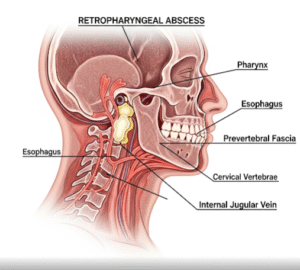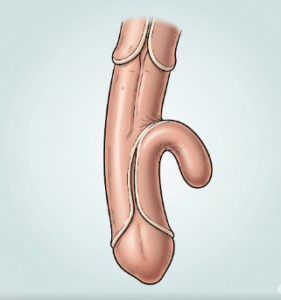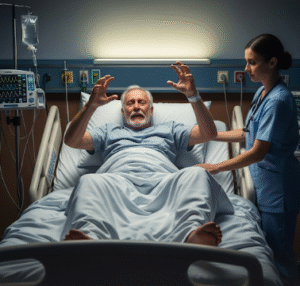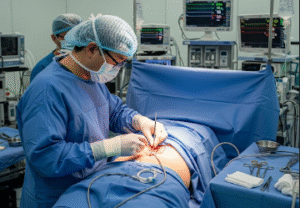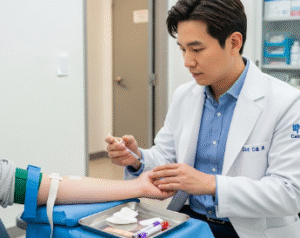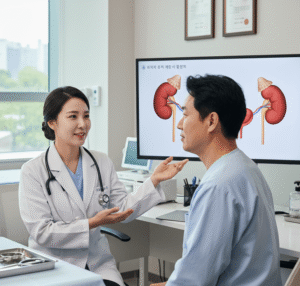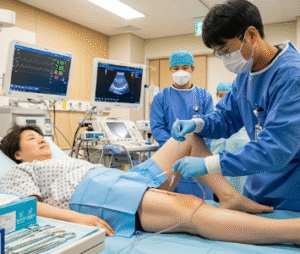Overview
Flank pain is discomfort or pain located on the side of the body between the lower ribs and the hip, commonly referred to as the flank region. This pain can be sharp, dull, or cramping, and may occur on one or both sides. Flank pain is often associated with kidney problems, urinary tract issues, muscular strain, or systemic conditions. In Korea, urology, nephrology, and general medicine clinics provide comprehensive diagnostic evaluation, imaging studies, and individualized treatment plans to address the underlying causes of flank pain effectively.
Highlights:
➤ Pain in the side region between the ribs and hip
➤ Can indicate renal, muscular, or systemic problems
➤ Early evaluation helps prevent complications
Key Facts
➤ Prevalence: Common complaint in both outpatient and emergency settings; exact prevalence varies depending on cause
➤ Age affected: Can occur at any age; renal causes more common in adults
➤ Gender: Affects both males and females; urinary stones more common in men
➤ Impact: May interfere with daily activities, sleep, and mobility
➤ Prognosis: Dependent on underlying cause; timely treatment improves outcomes
What is Flank Pain?
Flank pain is discomfort or aching in the lateral abdomen or back, often involving the kidneys, ureters, or surrounding muscles. Types include:
- Renal/ureteral pain: Often caused by kidney stones, infections, or obstruction
- Musculoskeletal pain: Muscle strain, ligament injury, or spinal issues
- Referred pain: From abdominal organs such as the liver, pancreas, or intestines
- Acute vs. chronic: Sudden sharp pain may indicate stones or infection, while dull chronic pain may reflect muscle strain or kidney disease
Highlights:
➤ Flank pain can be acute or chronic, mild or severe
➤ Location and character provide clues to underlying cause
➤ Medical evaluation is essential for accurate diagnosis
What Symptoms Are Related to Flank Pain?
➤ Sharp, stabbing, or dull ache in the flank area
➤ Pain radiating to the groin or lower abdomen – Often seen with kidney stones
➤ Urinary symptoms: Frequent urination, burning sensation, or blood in urine
➤ Fever and chills: Suggestive of kidney infection (pyelonephritis)
➤ Nausea or vomiting: Common with renal colic or severe infection
➤ Muscle tenderness: Present with musculoskeletal causes
➤ Other systemic signs: Fatigue or swelling may indicate underlying kidney disease
Highlights:
➣ Symptom patterns help differentiate between renal, musculoskeletal, and systemic causes
➣ Accompanying urinary or systemic symptoms require urgent evaluation
What Causes / Possible Causes
➤ Kidney stones (renal calculi): Sharp, colicky pain due to obstruction of the ureter
➤ Urinary tract infections (UTIs): Infection of the kidneys or ureters causing dull flank pain
➤ Kidney infection (pyelonephritis): Often associated with fever, chills, and urinary symptoms
➤ Musculoskeletal causes: Muscle strain, ligament injury, or herniated discs
➤ Abdominal organ issues: Liver, pancreas, or gallbladder disease may cause referred flank pain
➤ Trauma or injury: Direct injury to the flank or lower back
➤ Chronic conditions: Polycystic kidney disease or chronic kidney disease
➤ Other causes: Shingles (herpes zoster) affecting the flank nerves
Highlights:
➣ Causes range from benign muscular issues to serious renal or systemic conditions
➣ Identifying the primary cause is critical for effective treatment
When Should I See My Doctor?
➤ Sudden, severe, or colicky flank pain – May indicate kidney stones or obstruction
➤ Pain with fever, chills, or urinary symptoms – Possible kidney infection requiring urgent care
➤ Persistent or worsening pain – Chronic kidney disease or musculoskeletal problems
➤ Blood in urine – Could indicate stones, infection, or malignancy
➤ History of trauma or injury – May require imaging to rule out fractures or internal bleeding
Highlights:
➣ Early consultation at a Korean urology or nephrology clinic ensures proper diagnosis
➣ Timely intervention prevents complications such as infection or renal damage
Care and Treatment
➤ Medications:
- Pain relievers: NSAIDs or acetaminophen for mild to moderate pain
- Antibiotics: For urinary tract or kidney infections
- Alpha-blockers: Facilitate passage of kidney stones in selected cases
➤ Hydration: Encourages stone passage and supports kidney function
➤ Physical therapy: For musculoskeletal-related flank pain
➤ Lifestyle modifications: Diet changes, exercise, and avoiding heavy lifting for prevention
➤ Surgical or procedural intervention: - Extracorporeal shock wave lithotripsy (ESWL) for kidney stones
- Ureteroscopy or percutaneous nephrolithotomy for obstructive stones
- Surgery for severe musculoskeletal or abdominal organ causes
Highlights:
➣ Treatment depends on cause, severity, and patient condition
➣ Combination of medication, hydration, and procedural interventions often leads to relief
Treatment Options in Korea
Medical Treatments:
➤ Urology clinics: Diagnostic imaging (ultrasound, CT), blood and urine tests, prescription therapy
➤ Nephrology clinics: Management of kidney function and chronic kidney disease
➤ Physical therapy centers: Rehabilitation for musculoskeletal causes
Advanced Procedures:
➤ ESWL or lithotripsy: Non-invasive treatment for kidney stones
➤ Ureteroscopy: Minimally invasive stone removal
➤ Surgical intervention: For trauma, tumors, or severe obstruction
➤ Hospitalization: For severe infection, sepsis, or uncontrolled pain
Rehabilitation & Follow-Up Care:
➤ Education on hydration, diet, and lifestyle modifications
➤ Regular kidney function monitoring and imaging for stone recurrence
➤ Multidisciplinary support for long-term kidney health and musculoskeletal rehabilitation
Highlights:
➣ Korean clinics offer advanced diagnostics, individualized therapy, and long-term follow-up
➣ Early intervention ensures pain relief, prevention of complications, and improved quality of life



